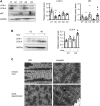Autophagy is Involved in Cardiac Remodeling in Response to Environmental Temperature Change
- PMID: 35514342
- PMCID: PMC9061941
- DOI: 10.3389/fphys.2022.864427
Autophagy is Involved in Cardiac Remodeling in Response to Environmental Temperature Change
Abstract
Objectives: To study the reversibility of cold-induced cardiac hypertrophy and the role of autophagy in this process. Background: Chronic exposure to cold is known to cause cardiac hypertrophy independent of blood pressure elevation. The reversibility of this process and the molecular mechanisms involved are unknown. Methods: Studies were performed in two-month-old mice exposed to cold (4°C) for 24 h or 10 days. After exposure, the animals were returned to room temperature (21°C) for 24 h or 1 week. Results: We found that chronic cold exposure significantly increased the heart weight/tibia length (HW/TL) ratio, the mean area of cardiomyocytes, and the expression of hypertrophy markers, but significantly decreased the expression of genes involved in fatty acid oxidation. Echocardiographic measurements confirmed hypertrophy development after chronic cold exposure. One week of deacclimation for cold-exposed mice fully reverted the morphological, functional, and gene expression indicators of cardiac hypertrophy. Experiments involving injection of leupeptin at 1 h before sacrifice (to block autophagic flux) indicated that cardiac autophagy was repressed under cold exposure and re-activated during the first 24 h after mice were returned to room temperature. Pharmacological blockage of autophagy for 1 week using chloroquine in mice subjected to deacclimation from cold significantly inhibited the reversion of cardiac hypertrophy. Conclusion: Our data indicate that mice exposed to cold develop a marked cardiac hypertrophy that is reversed after 1 week of deacclimation. We propose that autophagy is a major mechanism underlying the heart remodeling seen in response to cold exposure and its posterior reversion after deacclimation.
Keywords: autophagy; heart; hypertrophy; metabolism; temperature.
Copyright © 2022 Ruperez, Blasco-Roset, Kular, Cairo, Ferrer-Curriu, Villarroya, Zamora, Crispi, Villarroya and Planavila.
Conflict of interest statement
The authors declare that the research was conducted in the absence of any commercial or financial relationships that could be construed as a potential conflict of interest.
Figures





Similar articles
-
Attenuation of Low Ambient Temperature-Induced Myocardial Hypertrophy by Atorvastatin via Promoting Bcl-2 Expression.Cell Physiol Biochem. 2017;41(1):286-295. doi: 10.1159/000456111. Epub 2017 Jan 24. Cell Physiol Biochem. 2017. PMID: 28214881
-
The effects of acute cold exposure on morphology and gene expression in the heart of neonatal chicks.J Comp Physiol B. 2016 Apr;186(3):363-72. doi: 10.1007/s00360-015-0957-x. Epub 2016 Jan 5. J Comp Physiol B. 2016. PMID: 26733397
-
Cold stress accentuates pressure overload-induced cardiac hypertrophy and contractile dysfunction: role of TRPV1/AMPK-mediated autophagy.Biochem Biophys Res Commun. 2013 Dec 6;442(1-2):8-15. doi: 10.1016/j.bbrc.2013.10.128. Epub 2013 Nov 5. Biochem Biophys Res Commun. 2013. PMID: 24211590
-
Irisin alleviates pressure overload-induced cardiac hypertrophy by inducing protective autophagy via mTOR-independent activation of the AMPK-ULK1 pathway.J Mol Cell Cardiol. 2018 Aug;121:242-255. doi: 10.1016/j.yjmcc.2018.07.250. Epub 2018 Jul 24. J Mol Cell Cardiol. 2018. PMID: 30053525
-
Autophagic control of cardiac steatosis through FGF21 in obesity-associated cardiomyopathy.Int J Cardiol. 2018 Jun 1;260:163-170. doi: 10.1016/j.ijcard.2018.02.109. Epub 2018 Mar 5. Int J Cardiol. 2018. PMID: 29519677
Cited by
-
Heavy Metal Scavenger Metallothionein Rescues Against Cold Stress-Evoked Myocardial Contractile Anomalies Through Regulation of Mitophagy.Cardiovasc Toxicol. 2024 Feb;24(2):85-101. doi: 10.1007/s12012-023-09823-4. Epub 2024 Feb 14. Cardiovasc Toxicol. 2024. PMID: 38356081
-
The Effect of Temperature on the Embryo Development of Cephalopod Sepiella japonica Suggests Crosstalk between Autophagy and Apoptosis.Int J Mol Sci. 2023 Oct 19;24(20):15365. doi: 10.3390/ijms242015365. Int J Mol Sci. 2023. PMID: 37895043 Free PMC article.
-
CIRBP Enhances the Function of Yak Cumulus Cells by Activating AMPK/mTOR-Mediated Mitophagy.Biomolecules. 2025 May 24;15(6):759. doi: 10.3390/biom15060759. Biomolecules. 2025. PMID: 40563401 Free PMC article.
-
Research progress of autophagy in heart failure.Am J Transl Res. 2024 May 15;16(5):1991-2000. doi: 10.62347/OBXQ9477. eCollection 2024. Am J Transl Res. 2024. PMID: 38883358 Free PMC article. Review.
-
Acyl CoA-binding protein in brown adipose tissue acts as a negative regulator of adaptive thermogenesis.Mol Metab. 2025 Jun;96:102153. doi: 10.1016/j.molmet.2025.102153. Epub 2025 Apr 11. Mol Metab. 2025. PMID: 40220929 Free PMC article.

